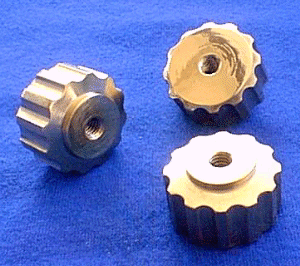

The three Brass Collimation Knobs, (ABOVE), were made by a fellow amateur astronomer and close friend, Jim, and were machined from a 1" round piece of brass bar stock. In my case, this modification came very cheep, about $15.00.
NOTE:
All bolts and bolt retainers used on the Starfinder are 1/4"-20 threads.There is no sense for me to present additional pages on Collimation as there are a couple really great sites on the Internet already that cover Collimation very well. Therefore, if you are interested in reading up on Collimation of the Primary and Secondary mirrors of your Starfinder, and I would recommend it, just click on the URL link below.I would also like to recommend getting Orion's LaserMate Collimator for precision collimation. The LaserMate Collimator can also be obtained from Orion Telescopes.